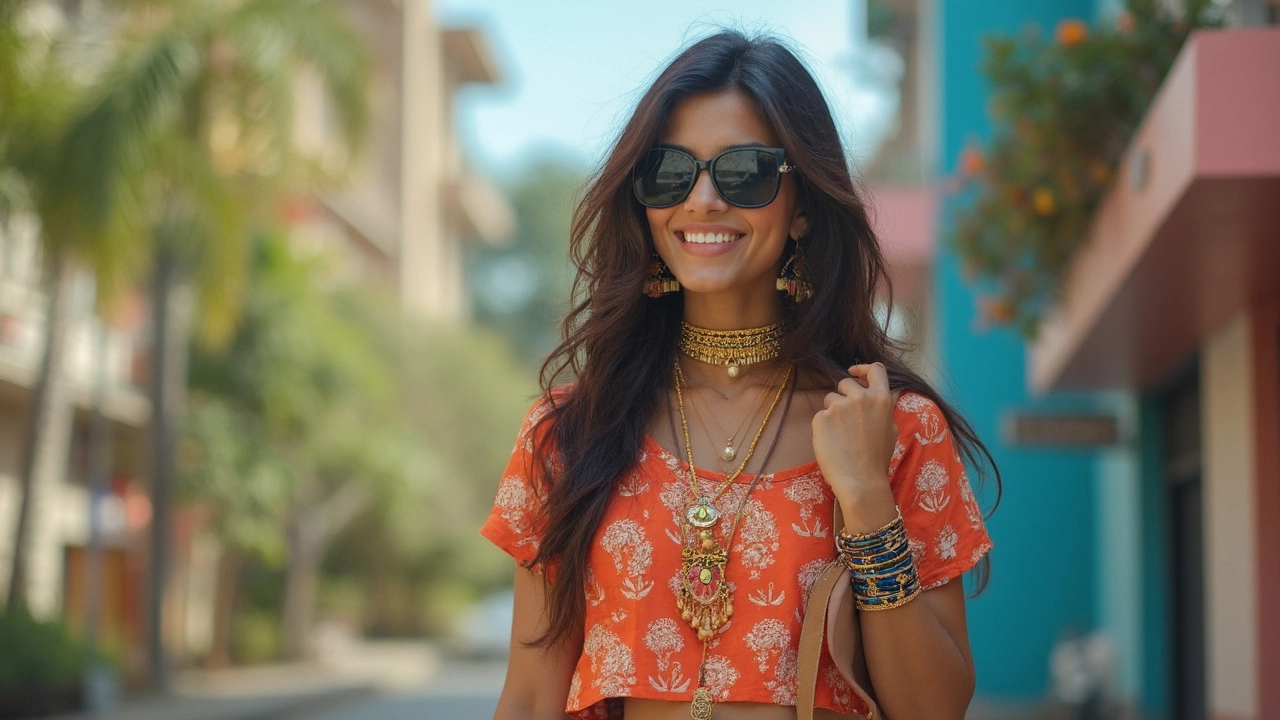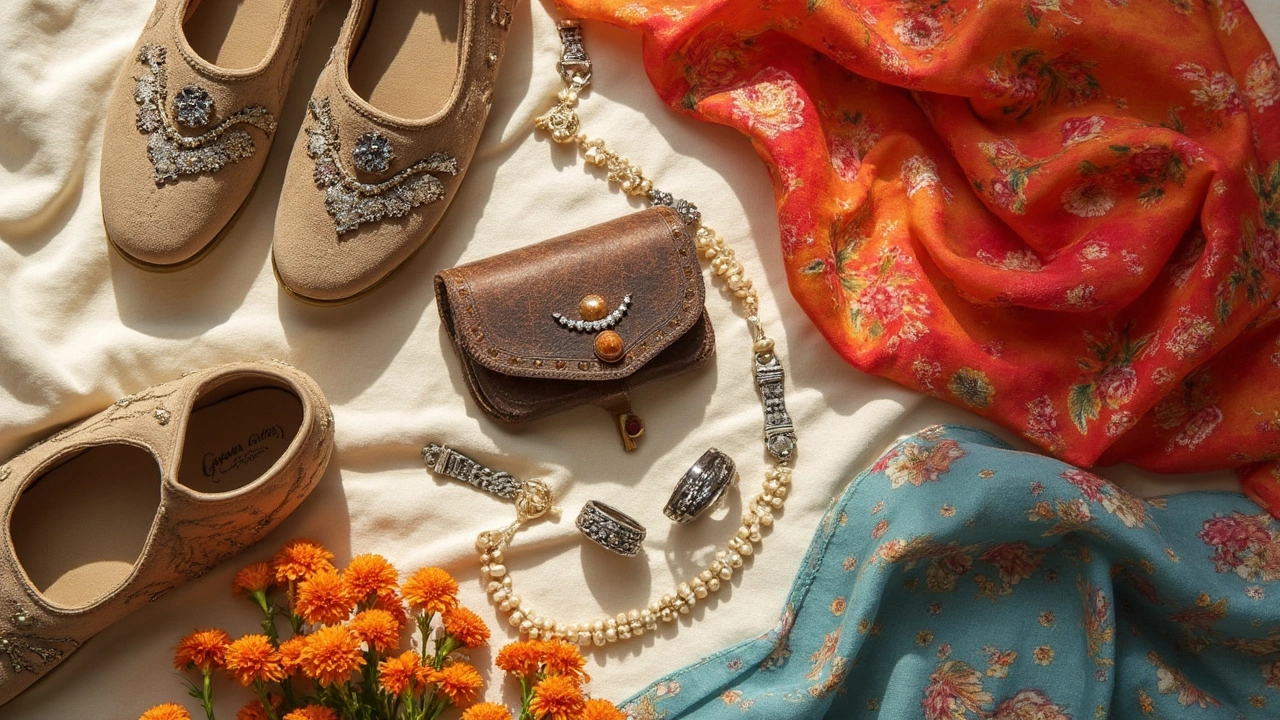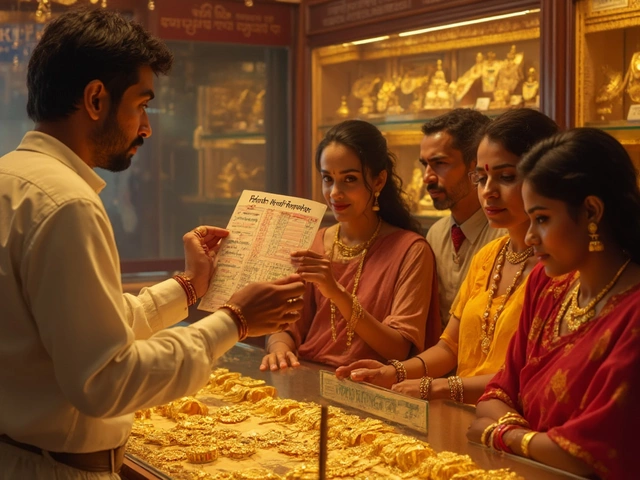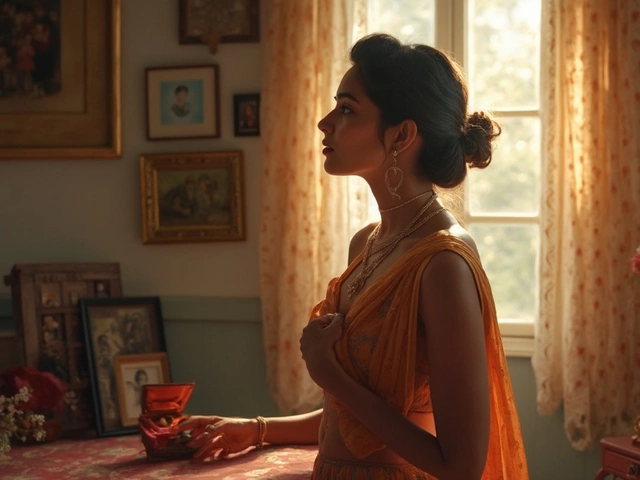
Everyone’s got their own idea of what looks cool, but when it comes to fashion accessories in India, things get interesting. You’ve got grandmas collecting chunky silver bangles, college kids rocking those tiny crossbody bags, and even my son Felix wants a bright beaded bracelet for every outfit. So, what exactly turns an average item into a legit fashionable accessory?
It actually comes down to two things: does it add personality, and does it work with your lifestyle? Maybe you’re into statement earrings that stand out at a party, or you just need a sturdy tote for your daily commute. The best accessories aren’t just about pulling your look together—they make getting through the day easier and more fun. In India, this means mixing the old with the new and not being afraid to try bold colors or traditional touches. If you’ve ever wondered how to pick pieces that aren’t boring or overdone, you’re not alone. Ready to find out how style and sensibility meet right here?
- Defining a Fashionable Accessory in Everyday Life
- Popular Accessories: From Classic to Quirky
- How Indian Culture Shapes Style Choices
- Tips on Mixing and Matching Accessories
- Seasonal Trends and What’s Hot Right Now
- Smart Shopping: Finding Value and Authenticity
Defining a Fashionable Accessory in Everyday Life
So, what actually makes something a fashionable accessory? It’s not just about looks—it’s about how the piece fits in with your outfit and your routine. Take watches, for example. A smart digital watch is perfect for someone who wants to track their run or get texts on the go, while a classic gold watch can totally lift your style during a festival or at work. That blend of function and style is what separates a must-have accessory from just another item in the drawer.
In India, everything from juttis (traditional shoes) to clutches, studded belts, and those colorful scarves count as fashion accessories. You don’t need to buy expensive designer stuff to look trendy. People from all walks of life mix local street finds with branded gear to make their own style statement. The trick? Make sure whatever you pick works for your daily activities—nobody wants to fuss with heavy earrings at a workout or a delicate silk scarf on a rainy commute.
Here are a few things that usually define an accessory as fashionable in everyday life:
- It completes your look – Bold sunglasses or a funky bag can turn a plain jeans-and-tee combo into something interesting.
- It suits your lifestyle – If you’re on your feet all day, flat sandals are just as stylish as heels for the right occasion.
- It shows some personality – Maybe you go for a hat with a wild print, or you layer on silver anklets. Don’t be shy about standing out.
- It’s current but classic – The best accessories nod to trends but can be used again and again. Think leather wallets, hoop earrings, or a khadi sling bag.
By the way, in 2024, a survey by FashionUnited showed that over 68% of young shoppers in India scored accessories as the easiest way to ‘try out trends’ without spending a fortune on new clothes. That says a lot about how key accessories are for daily style here.
Popular Accessories: From Classic to Quirky
In India, fashionable accessory doesn’t just mean something expensive or brand-name. It’s about finding the right balance between comfort, utility, and turning a few heads. Some things never go out of style, especially when old-school charm and quirky twists come together.
Let’s take a look at the accessories that everyone’s talking about, from must-haves to the latest eye-catchers:
- Bangles and Bracelets: Talk to any Indian auntie or scroll through Instagram—bangles are everywhere. Gold and silver never lost their shine, but you’ll also see colorful lacquer bangles or beaded ones in college corridors and family functions. Guys are into chunky leather bands and funky friendship bracelets, too.
- Scarves and Dupattas: It’s not just about covering up. Cotton scarves, silk stoles, and printed dupattas can totally change an outfit. Go to Delhi’s Janpath or Mumbai’s Linking Road and you’ll see them on everyone from office-goers to students. The right scarf is a fashion accessories India staple.
- Earrings: Jhumkas, hoops, studs, you name it. Small silver shops on street corners sell quirky pairs for less than the price of a coffee. Big statement earrings are perfect for weddings and work just as well at Sunday brunch with jeans.
- Bags: Right now, sling bags and mini-backpacks are winning popularity contests. Totes and potli bags bring out a mix of east and west, and are both handy and stylish. Even the humble canvas tote is back, showing off quotes or prints—super practical for daily use.
- Watches: Digital, analog, smart—watches are still a big deal. Even with everyone glued to their phones, a cool watch is a finishing touch, especially when you want to look serious at work or casual at a café.
- Footwear: Mojaris, Kolhapuris, and sneakers are fighting for closet space. Pairing traditional shoes with jeans or ethnic outfits is something everyone’s doing, not just celebrities.
So how are people mixing it up? Younger folks love quirky pins, patches on backpacks, and even neon shoelaces. There’s a recent survey (by Myntra, 2024) that says 63% of college students add at least one “unusual” piece to their look every day, whether it’s keychains or badges.
Don’t feel like you have to follow every trend. The most stylish people know how to own a look, whether it’s a stack of classic rings or that one crazy, oversized pair of sunglasses. The trick is to start with the basics, then add your own twist.
How Indian Culture Shapes Style Choices
When you think about fashion accessories India, there’s this giant mashup of old-school tradition and what’s trending right now on Instagram. Indian culture has always been big on using accessories as more than just extra stuff to wear—they’ve often got meaning. For example, a simple pair of gold jhumkas isn’t just jewelry; they show off family heritage, and sometimes, even hint if someone’s married or what part of the country they come from.
Look at weddings, where accessories are practically compulsory. Think of mangalsutras, chunky wedding bangles, and payals (anklets)—each piece ties into some deep-rooted significance. Even outside big events, certain accessories like the bindi or nose pin go way beyond fashion; they represent identity, religion, or social status. A lot of folks wear these because it’s part of who they are, not just because it looks nice.
But here’s the thing: people mix it up all the time. Take something classic, like a silk scarf or a pair of embroidered mojaris (traditional shoes), and suddenly you’ll see it next to ripped jeans or business suits. Gen Z isn’t shy about matching antique silver jewelry with their favorite T-shirts. It’s just normal to see this wild blend of current style and old tradition—which is part of what makes the accessory scene in India unique.
If you’re wondering how much influence Indian culture has on everyday looks, check out these numbers from a 2023 market report:
| Accessory Type | % of Urban Users |
|---|---|
| Bangles/Bracelets | 67% |
| Earrings/Jhumkas | 82% |
| Bindis & Tikkas | 45% |
| Scarves/Dupattas | 53% |
At the end of the day, fashionable accessories aren’t just about looking put together. In India, they help people say where they’re from and what they care about—even if it’s as simple as Felix begging for a flashy festival wristband every year.

Tips on Mixing and Matching Accessories
Mixing and matching fashionable accessories sounds simple, but it’s where most people get stuck. I’ve seen friends load up on funky belts, sunglasses, and scarves, then wonder why nothing fits together. Here’s how to make this work, especially if you want that effortless look that stands out in India’s busy style scene.
First, stick to one or two statement pieces. If you’ve got a loud necklace or those oversized jhumkas everyone’s wearing, let them shine. Keep the rest of your accessories subtle. For instance, pair chunky bangles with simple studs, or if your bag is eye-catching, leave the patterned scarf at home that day.
- Choose a main color scheme. When you pick accessories, try matching two or three colors that go well together. Earthy tones (like golds and browns) or classic black and white always work. This trick is everywhere in Mumbai street fashion—nobody wants a clashing rainbow mess.
- Layer, but don’t go overboard. Stacking bracelets and thin chains looks cool, but once you add four or more, it can look cluttered. Keep it to two or three layered items for a clean vibe.
- Don’t ignore functionality. In India, practicality counts. Sunglasses, watches, or bags should not just look good—they should fit your routine. Too-small sling bags might be trendy, but if you can’t squeeze in your phone, they’re useless.
- Mix cultures and textures. It’s totally normal to see someone sporting a western tote with a traditional dupatta or ethnic earrings with jeans. This blend is what gives Indian fashion accessories an edge globally.
- Work with your outfit. Accessories shouldn’t overpower what you’re wearing. A busy kurta needs simple add-ons, but if you’re in a plain outfit, go bold with patterns or shine.
Here’s a quick look at what people typically mix in daily Indian fashion:
| Main Outfit | Usual Pairing | Tip |
|---|---|---|
| Kurta & Jeans | Ethnic jhumkas, Kolhapuri sandals | Stick to one bold accessory |
| Office Shirt & Trousers | Watch, silk scarf, tote bag | Neutral colors look sharp |
| Western Dress | Statement necklace, clutch | Match metals and stones |
The last word: Don’t try to copy every trend. The best combinations come from trying things out and trusting your gut. Soon enough, your mix-and-match game will turn you into the go-to style expert in your group. That’s what really counts in fashion accessories India—confidence and a bit of experimenting.
Seasonal Trends and What’s Hot Right Now
Let’s be real: every season in India brings a fresh wave of fashionable accessory trends, and it’s not just about what’s on runways. Right now (April 2025), the summer heat is pushing people toward lighter, more playful picks. Chunky resin bangles in neon shades are everywhere—from Instagram reels to local flea markets—because they’re cheap, fun, and don’t feel sticky in the heat. Small embroidered pouches and slings made with recycled fabric are making a splash, too, especially since a lot of local brands are pushing the sustainability angle. They tick the style box and make you feel good about your shopping.
If you’re shopping for something practical, oversized sunglasses with thick, colored frames are going fast. Folks aren’t just going basic black—purple and electric blue are flying off the shelves at big chains and street stalls alike. Retro is hot again, so think cat-eye or even round Lennon-style shades. If you follow college trends, you’ll see stacked beaded necklaces and bracelets, especially ones made with customizable charms—Felix swears by his little Mumbai skyline charm on his wristband.
Here's a quick snapshot of what’s seriously hot in fashion accessories India this spring and summer:
- Bright, stackable resin bangles and rings (affordable, easy to style)
- Mini sling bags with hand-embroidered details
- Layered bead necklaces and chunky anklets
- Oversized, brightly-colored sunglasses
- Cotton bucket hats with quirky prints
If you’re into data, check this out—the Federation of Indian Chambers of Commerce and Industry (FICCI) reported last quarter that accessory sales in India saw a 15% jump, mostly driven by under-30s buying more colorful pieces and personalized items. Thanks to e-commerce and Insta shopping, new designs reach everyone in days, not months.
So, if you want to stay current with what’s hot, start with color, comfort, and a touch of personal flavor. Don’t forget, Indian summers call for breathable stuff—avoid anything that feels sticky or heavy, because nobody looks stylish when they’re uncomfortable.
Smart Shopping: Finding Value and Authenticity
There’s a fine line between a solid deal and a total rip-off when it comes to fashion accessories India has to offer. If you don’t want to pay too much for fake leather or a "gold" chain that turns green in a week, you need to pay attention to a few simple things.
First, always check the material. Handwoven bags, real silver jewelry, and good cotton scarves have a different feel than cheap, factory stuff. Flip the tag and look for the origin—"Made in India" or local artisan names usually signal the real deal. Genuine leather bags and belts should smell leathery, not plasticky.
Online shopping can be tricky, but most reliable sites in India—think Nykaa Fashion or Myntra—show close-up pictures and offer customer reviews. If a product has tons of negative reviews, best to skip it. Also, on Instagram or markets, ask sellers straight up if the accessory is handmade or if it’s machine printed. Honest sellers will tell you.
- For jewelry, look for hallmarks if you’re buying anything that claims to be silver or gold.
- For bags and wallets, check the stitching—uneven threads are usually a red flag for cheap mass production.
- When hunting for ethnic or traditional stuff, ask about the craft story. Hand-painted or embroidered pieces usually come with a bit of background. If someone can’t explain where it comes from, it’s probably not unique or handmade.
Don’t let "trendy" fool you into overpaying. Basic cotton totes can go for under ₹500, and good-quality oxidized jewelry often costs less if you buy directly from the artisan at exhibitions or craft fairs. Here’s the real kicker: a National Handicrafts report said in 2024, over 60% of shoppers in metro cities bought at least one accessory directly from artisans—both for price and authenticity.
| Accessory | Average Price (Direct from Artisan) | Average Price (Big Brand/Store) |
|---|---|---|
| Handmade Jhumkas | ₹250 | ₹600+ |
| Block print scarf | ₹350 | ₹900+ |
| Kantha stitched bag | ₹700 | ₹1500+ |
Cut out the middleman when you can. You’ll support local craftspeople and score a better price. Stick to these basics and you’ll spot the winners from the wannabes every time you shop for fashionable accessory pieces across India.


